Abstract
Nikolai N. Anichkov (1885–1964) first demonstrated the role of cholesterol in the development of atherosclerosis. His classic experiments in 1913 paved the way to our current understanding of the role of cholesterol in cardiovascular disease. Anichkov's research is often cited among the greatest discoveries of the 20th century; however, little is known about Anichkov and his team. Herein, we give a detailed historical account of Anichkov's work, his personality, his research team, and their pioneering effort.
Key words: Anichkov NN; Anitschkow NN; arteriosclerosis; atherosclerosis; biography; cardiology/history; cardiovascular diseases/diagnosis/pathology; cholesterine; cholesterol; history, 20th century; USSR
Elucidation of the role of cholesterol in the pathogenesis of atherosclerosis is often referred to as one of the greatest discoveries of the 20th century.1,2 Felix Marchand apparently first introduced the term “atherosclerosis” in 1904, and he suggested that atherosclerosis was responsible for almost all obstructive processes in the arteries.3 In 1908, A.I. Ignatowski described a relationship between cholesterol-rich food and experimental atherosclerosis.4 In 1910, Adolf Windaus showed that atheromatous lesions contained 6 times as much free cholesterol and 20 times as much esterified cholesterol as a normal arterial wall.5 Then, in 1913, Nikolai N. Anichkov showed that cholesterol alone caused the atheromatous changes in the vascular wall.6,7 This discovery introduced a new era in the studies of atherosclerosis. In 1958, in an editorial in Annals of Internal Medicine, William Dock compared the significance of the classic work of Anichkov to that of the discovery of the tubercle bacillus by Robert Koch.8
Although Anichkov's classic paper is cited in virtually every historical review on atherosclerosis, little is known about the personality of Nikolai N. Anichkov (1885–1964), his educational background, and his research team.9,10
Biography
Nikolai Nikolaevich Anichkov (often spelled Anitschkow in the German literature) was born on 3 November 1885 in St. Petersburg, Russia. His father, Nikolai Milievich Anichkov (1844–1916), was a very well educated man who held the high-ranking government position of Vice-Minister of Education of the Russian Empire. His mother, Lubov I. Vasiliyeva (1859–1924), was the daughter of a priest of the Alexander Nevsky Orthodox church in Rue Daru, Paris; she moved to Russia after the marriage. In 1903, Anichkov entered the Imperial Military Medical Academy in St. Petersburg (Fig. 1). There, he was a pupil of Alexander Maximow's (1874–1928) and later, in Freiberg, a pupil of Karl Albert Ludwig Aschoff's (1866–1942) (Fig. 2). Alexander Maximow was a professor of histology at the Military Medical Academy. He developed a unitarian theory of hemopoiesis and published one of the world's most advanced textbooks of medical histology, which ran in 12 editions.11 It was under the tutelage of Maximow that Anichkov gained a thorough knowledge of experimental histology and histopathology. Apparently, Maximow and Anichkov became close friends. Before his escape from Russia after the revolution, Maximow left, in Anichkov's home for storage, some personal belongings that were especially dear to him.12 Subsequently, when Maximow obtained a professorship at the University of Chicago, he tried to arrange for Anichkov to visit America in the mid-1920s, a visit that Soviet officials never permitted.12
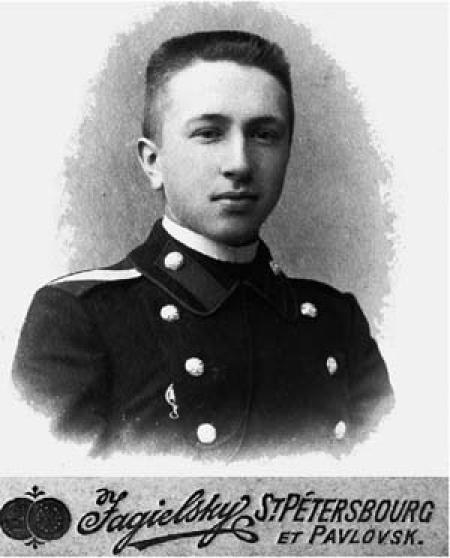
Fig. 1 Nikolai N. Anichkov as a student at the Imperial Military Medical Academy, ca 1904. (Courtesy of the Anichkov family.)
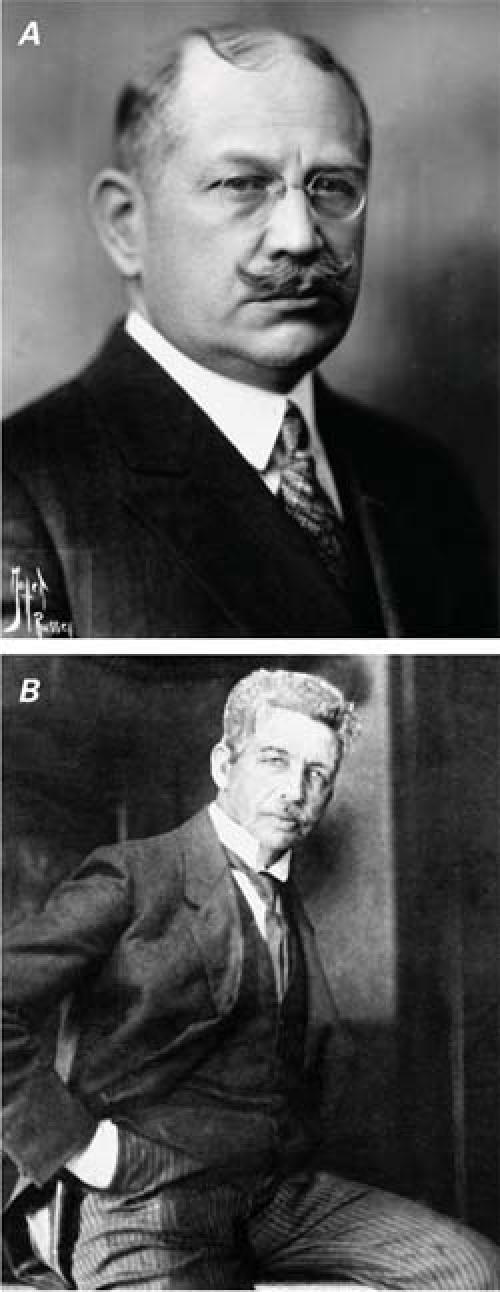
Fig. 2 A) Alexander A. Maximow (1874–1928) as a professor at the University of Chicago, ca 1920s. B) Karl Albert Ludwig Aschoff (1866–1942) as a professor at the University of Freiburg, ca 1910. (Courtesy of the Anichkov family.)
In 1908, Anichkov became interested in the work of Dr. Ignatowski, an associate professor in the department of internal medicine at the Military Medical Academy, whose preliminary work suggested that rabbits might develop atherosclerosis after eating non-vegetarian food, including meat and eggs. Upon his graduation in 1909 (Fig. 3), Anichkov began to work on his doctoral thesis (for the equivalent of a modern PhD), titled “Inflammatory changes in myocardium: apropos of myocarditis,” and he successfully defended it on 21 April 1912. In this work, Anichkov introduced foreign bodies into the myocardium of experimental animals and studied the inflammatory response that occurred during periods from 2 hours to 1 year afterward. In this thesis, Anichkov first described the myocyte that today bears his name. He believed that these “Anitschkow cells” were a result of the degeneration of myocardial cells that were losing their contractile ability. The chromatin that concentrated in the nucleus had the appearance, in Anichkov's own words, of a “bottle brush.” At the same time, Anichkov worked on an experimental model of atherosclerosis together with an undergraduate student at the Imperial Military Medical Academy, Semen S. Chalatov.*,1 On 16 December 1911, in his report at a meeting of the Russian Society of Pathologists titled “Response of the liver to different sorts of food fat,” Chalatov said, “…together with Dr. N.N. Anichkov, who aimed to determine the results of this sort of feeding on aorta, we conducted a series of experiments….”12,13 This was the 1st report of the emerging model of experimental atherosclerosis, which was recognized as “classic” and used by a great number of researchers. In 1912, Anichkov was awarded a traveling fellowship from the Military Medical Academy, which enabled him to work in 2 laboratories in Germany. In February 1913, Anichkov arrived in Strasbourg to work in the laboratory of the famous Austrian pathologist Hans Chiari (1851–1916). On 15 April 1915, Anichkov wrote in a letter to Chalatov,
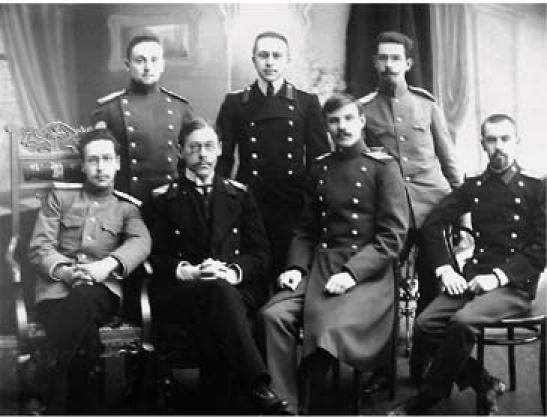
Fig. 3 Dr. Anichkov (2nd row, standing in the middle) with his classmates upon graduation from the Imperial Military Medical Academy in St. Petersburg in 1909. (Courtesy of the Anichkov family.)
Recently I was gladdened. Once a year Chiari delivers a course with specimen demonstrations for the military doctors, which he considers of extreme importance. Chiari prepares his lectures for the course far in advance and selects the most interesting specimens. Prior to his last lecture, Chiari asked me to bring the specimen of the aorta of our last rabbit and demonstrate the microscopy to the audience, saying that it was of extreme interest to his colleagues and the entire audience. Finishing his lecture, Chiari summarized the findings of our work published in Zentralblatt and showed all our microscopic specimens. Now everyone here is extremely interested in our work.12
In a couple of months, Anichkov moved to Freiburg to work under Dr. Aschoff, who at that time was considered the most accomplished of all German pathologists. Aschoff was very interested in Anichkov's early experimental work.12–14 Aschoff's laboratory attracted visiting doctors from all over the world, including Japan, Russia, and the United States (Fig. 4). Some of these research scientists had already established their names in pathology, such as Carl von Sternberg (1872–1935), an Austrian pathologist who in 1898 gave the 1st detailed description of giant connective tissue cells with 1 or 2 large nuclei, which are known today as Reed-Sternberg cells and are characteristic of the lesions of Hodgkin's disease. Thus, Anichkov worked in the most advanced scientific environment of the time. While studying the cardiac lesions of acute rheumatic fever, the lesions that are known today as Aschoff bodies, Anichkov noticed a familiar cell that he had first observed and described in his doctoral thesis—a large mononuclear cell with a wavy, “caterpillar-like” appearance of nuclear chromatin. The ovoid nucleus contained a central chromatin mass that appeared as a wavy bar in the longitudinal section. These cells are referred to today as Anitschkow myocytes, cardiac histiocytes, or caterpillar cells. Lesser known is the fact that Anichkov was the first to describe the “cholesterinesterphagozyten,” which derive from macrophages and today are known as foam cells. By analyzing atherosclerotic plaque's development and histology, Anichkov identified the cell types involved in the atherosclerotic process: smooth muscle cells, macrophages, and lymphocytes. Anichkov had exceptional artistic skills, acquired under the tutelage of Maximow, and made precise sketches to illustrate most of his papers. Some of his sketches made it into Bremer's textbook of histology.15
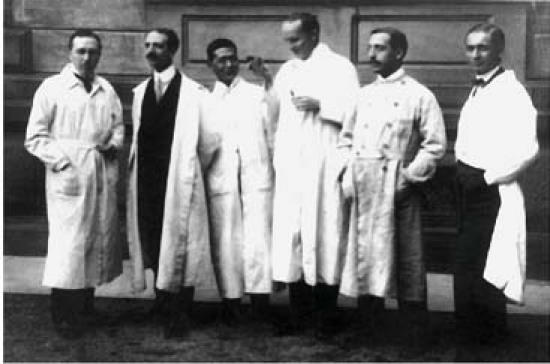
Fig. 4 Dr. Anichkov (1st on the left) and co-workers in front of Dr. Aschoff's laboratory, ca 1913; and Dr. Karl Sternberg (2nd on the left). (Courtesy of the Anichkov family.)
While in Germany, Anichkov maintained regular correspondence with his research coworkers in Russia. On 4 May 1913, Anichkov wrote to his friend Vselvolod A. Zinserling,* who was still a medical student at that time and was involved in Anichkov's research at the Military Medical Academy. He described a detailed plan for further research into atherosclerosis, to be undertaken back home. The following lines are of particular interest:
…Now almost every second person I meet here is interested in cholesterin and is going to study “cholesterol” queries. In Aschoff's laboratory, in addition to me, this matter is being researched by Aschoff himself, his assistant Landau, and three other doctors. This indicates that all of us will need to hurry
…. Regarding atherosclerosis in humans—this question is very interesting, of course. To determine the influence of infection, we will have to study the aortas of children and young people who died of acute infections and, at the same time, of those young people who died of non-infective diseases. This topic is very large and, certainly, very worthy, especially in view of our previous experimental data…. Please, forward this letter to Chalatov.12
Anichkov had worked in Aschoff's laboratory for 14 months when World War I broke out in August 1914. The war interrupted the work of the visiting doctors in Aschoff's laboratory, since most of them had to leave for their home countries. For instance, von Sternberg was mobilized in 1914 and spent the entire war with the combat troops; he earned a great reputation for fighting for soldiers' rights and well-being. He became one of the most decorated doctors of his military rank in Austria. Similarly, Anichkov spent the entire war with an active army. But first, while still in Germany, Anichkov was arrested and sent to a prisoner-of-war camp. Directly aided by Aschoff, he was soon released and was able to escape to neutral Sweden and then to make his way to St. Petersburg. Anichkov joined the Russian Army Medical Corps and, from 1914 to 1917, was appointed as a physician-in-charge to one of the military medical evacuation trains that transported wounded soldiers from the front line to the stationary hospitals (Fig. 5A). During this time, he married a nurse (Fig. 5B), Nataliya M. Mutapholo (1888–1942). In 1920, Anichkov's only son, Mily N. Anichkov (d. 1991), was born. Mily subsequently became a professor of surgery and worked in St. Petersburg.
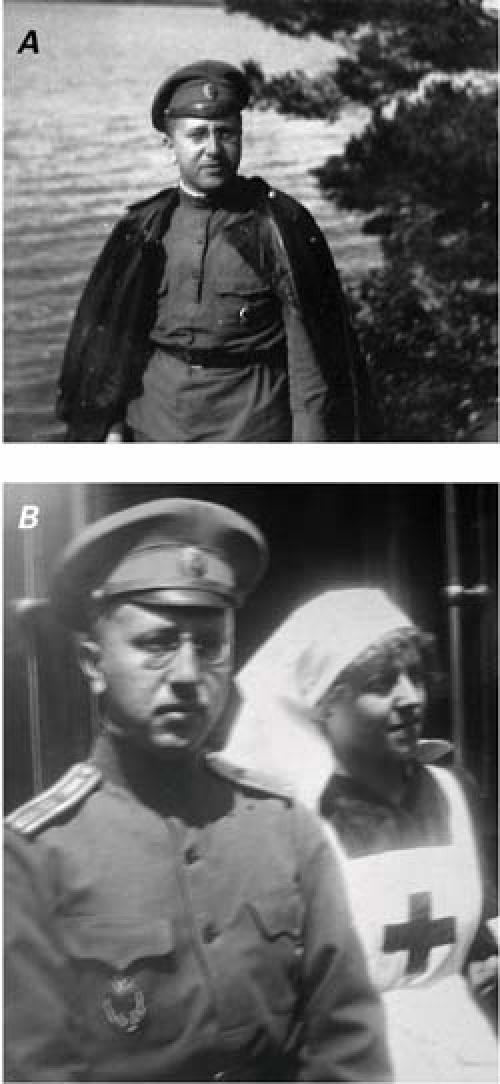
Fig. 5 A) Dr. Anichkov as a medical officer during World War I, ca 1915. B) Dr. Anichkov in the company of his wife-to-be, Nataliya Mutapholo, ca 1915. (Courtesy of the Anichkov family.)
In 1920, Anichkov was appointed head of the department of pathological physiology of the Military Medical Academy (Fig. 6), a position that he held until 1939. In 1923, Anichkov visited Berlin and Freiburg, where he delivered lectures on atherosclerosis and spent a few weeks with Aschoff. Subsequently, Anichkov presented updates on atherosclerosis research at the Congresses of German Pathologists in Würzburg in 1925 and Wiesbaden in 1928, and at meetings of the Swedish Society of Pathologists in Stockholm in 1926, the Medical Society of Japan in Osaka in 1930, and the International Society of Geographic Pathology in Utrecht in 1934.12 In 1930, after the congress in Osaka, where Anichkov had presented an invited lecture titled “On pathogenesis and aetiology of arteriosclerosis,” he went to Tokyo, Niigata, and Kyoto, to deliver a lecture “On experimental atherosclerosis of the coronary arteries of the heart.”12 Anichkov's work on atherosclerosis was gaining worldwide recognition, and he started to write a book on the subject.16 Of interest are the following 2 letters from Aschoff addressed to Anichkov. On 10 June 1929, Aschoff wrote: “How is your work on your large monograph on atherosclerosis? I know how many ideas are conceived in your head, and, thus, I do not want to hurry you. But you are truly destined to write a great summary work on atherosclerosis. I would very much like to discuss with you a few problems in modern pathology and, in particular, the most recent papers of Maximow. I suppose that his extensive article will, finally, be published in the next issue of Ziegler's Beitraege. In as much as I respect Maximow, I cannot agree with him on the origin of polyblasts from lymphocytes.”12 Although Anichkov never had time to complete his book, it was published in part as a chapter in E.V. Cowdry's Arteriosclerosis: A Survey of the Problem, in 1933.17,18 On 20 March 1933, Aschoff wrote, “I am always happy to see the successful work done at your institution. Recently, I reviewed the article of K. Volkova on the atherosclerosis of the arteries of the brain. Extremely important article! This morning I received the manuscript of Mandelstam. I read it immediately and accepted it with great pleasure for publication in Ziegler's Beitraege.”12
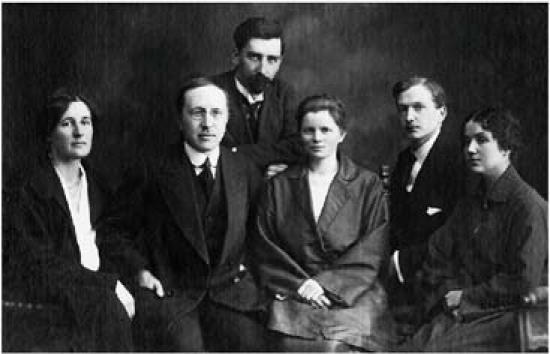
Fig. 6 Dr. Anichkov and his research team in St. Petersburg, ca 1920s. From left to right: Drs. M.I. Hesse, N.N. Anichkov, V.D. Zinserling, A.K. Nakonechnaya, A.A. Soloviyov, and K.G. Volkova. (Courtesy of the Anichkov family.)
From 1939 through 1946, Anichkov headed the Military Medical Academy's department of pathological anatomy. In 1941, as German troops advanced to encircle Leningrad, Anichkov and the entire staff of the Academy were evacuated to Samarkand in Uzbekistan, where he remained for the duration of World War II. In 1942, Anichkov and Dr. Alexei I. Abrikosov received a state award for their textbook Pathological Anatomy of the Heart and Vessels, in which they gave a detailed account of the development of atherosclerosis and ischemic heart disease. Anichkov's team published extensively on coronary atherosclerosis,19–22 and their work paved the road to the world's 1st coronary bypass operations, performed in Russia.23,24
In their 1998 book titled Medicine's 10 Greatest Discoveries, Friedman and Friedland wrote about Anichkov, “In 1917 he joined the Bolshevik Party and remained a loyal Communist for the rest of his life.”1 They further speculated, “Perhaps the lack of international recognition stemmed from his disinclination to become well recognized outside Russia. One need only peruse his Slavic face, with its high forehead and cheekbones, to recognize it as the visage of a man who was neither gregarious nor benevolent. Indeed, his was the face of a full-fledged Communist of 1918 Bolshevist provenance. It might remind one of a judge's countenance as he pronounced not a death sentence, but a prison term of 20 years. In sum, it was the face of a man not cruel, but not easily given to compassion.”1 To the contrary, Anichkov was never a member of the Communist Party. He always believed that a physician should remain impartial and free of any political involvement. Contrary to Friedman and Friedland's speculations, Anichkov's children and colleagues remembered him as a kind-hearted man who was always fair to his coworkers and good to his friends. It is difficult to draw conclusions about someone's personality almost half a century after his death. One can only say that Anichkov was a descendant of Russian nobility, never joined the Communist Party, headed 2 departments of pathology (at the Research Institute of Experimental Medicine and at the Military Medical Academy), held the rank of Lieutenant General of the Medical Corps of the Army (Fig. 7), and became a president of the Academy of Medical Sciences of the USSR (1946–1953) (Fig. 8).
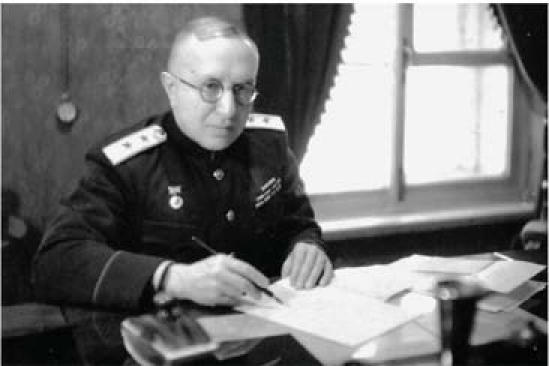
Fig. 7 Dr. Anichkov, in his office in 1945, in the uniform of a lieutenant general of the Soviet Army. (Courtesy of the Anichkov family.)
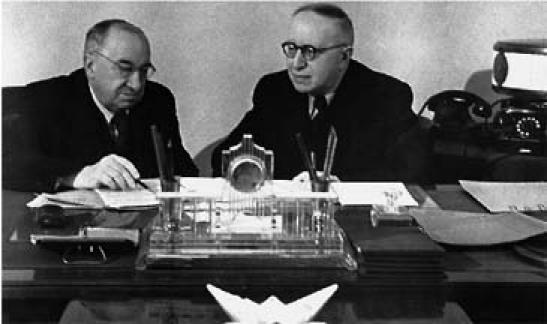
Fig. 8 Dr. Anichkov (right) as president of the Academy of Medical Sciences of the USSR, with Dr. A.I. Abrikosov in 1950. (Courtesy of the Anichkov family.)
Nikolai N. Anichkov died on 7 December 1964 of a myocardial infarction.1,25 His last article on atherosclerosis was published 3 months before his death.19
Recognition of Anichkov's Theory of Atherosclerosis
Apparently, the only reference to Anichkov's theory of atherosclerosis in the English-language medical literature before 1950 was a chapter written by Anichkov for the 1st edition of Cowdry's Arteriosclerosis (1933).17 A similar chapter appeared in the 2nd edition of the book, published in 1967.18 Anichov's work on coronary atherosclerosis was published in Circulation in 1964.19 However, worldwide recognition of Anichkov's early experiments probably came in 1950 after publication of a paper by Dr. John Gofman and his associates in Science.26 Gofman began by emphasizing that it was Anichkov who first discovered that feeding cholesterol to rabbits promptly led to atherosclerosis. Using Anichkov's technique, Gofman's group had confirmed that Anichkov was correct. Then they did something that Anichkov could not have done in 1912—they developed and used an ultracentrifuge capable of rotating its tubes 40,000 times per minute. The hypercholesteremic serum samples of their cholesterol-fed rabbits were centrifuged and then sequestered into 2 distinct compartments. The 1st fraction was designated low-density lipoprotein cholesterol, because it floated toward the surface of the serum sample. The 2nd fraction was deposited at the bottom and was designated high-density lipoprotein cholesterol.26 Gofman's group showed further that low-density lipoprotein cholesterol is responsible for the rapid progression of atherosclerosis in human beings. This work produced an avalanche of research in cholesterol-induced atherosclerosis in the mid-1950s and kindled an intense interest in the pioneering work of Anichkov. In 1952, Dr. Lawrence Kinsell and his associates showed that the ingestion of plant foods and avoidance of animal fats significantly decreased the blood level of cholesterol in most human beings.27 The same year, it was shown that the cholesterol-lowering effect of the vegetable fats was due to their unsaturation.28 During the next few years, millions of people worldwide tried to substitute vegetable for animal fats in their diet. This ever-expanding tendency has resulted in a rapid growth of industries that offer foods rich in unsaturated fats. In fact, almost every type of food we buy today carries on its label information about unsaturated fat and cholesterol content. In 1958, Dr. William Dock, who at that time was chairman of the department of pathology at Stanford University Medical School, wrote in an editorial, “Thus the early work of Anichkov bears comparison with that of Harvey on the circulation and of Lavoisier on the respiratory exchange of oxygen and carbon dioxide.”8
A century has passed since the word “atherosclerosis” was introduced. It seems timely to revisit the early pioneering effort of Anichkov and his colleagues and to acknowledge their contribution to the total sum of our present understanding of one of the most dreadful human diseases.
Acknowledgment
One of the authors of this article is a grandson of Dr. Nikolai N. Anichkov, and all original photographs and personal letters used in this paper were obtained from the family archives.
Footnotes
*Chalatov (1884–1951) graduated from the Military Medical Academy in 1912. He headed the departments of general pathology of the 1st Medical Institute in Leningrad (1922–1929) and pathological physiology of the 1st Medical Institute in Moscow (1929–1947); the Experimental Laboratory of the Central Institute of Oncology (1947–1950); and the Pathophysiology Laboratory of the Central Venerological Institute (1950–1951) in Moscow.
Address for reprints: Igor E. Konstantinov, MD, PhD, Division of Cardiovascular Surgery, Hospital for Sick Children, 555 University Avenue, Toronto M5G 1X8, Canada. E-mail: igorkonst@hotmail.com
References
- 1.Friedman M, Friedland GW. Medicine's 10 greatest discoveries. New Haven (CT): Yale University Press; 1998.
- 2.Mehta NJ, Khan IA. Cardiology's 10 greatest discoveries of the 20th century. Tex Heart Inst J 2002;29:164–71. [PMC free article] [PubMed]
- 3.Marchand F. Ueber Atherosclerosis. Verhandlungen der Kongresse fuer Innere Medizin. 21 Kongresse, 1904.
- 4.Ignatowski AI. Ueber die Wirkung der tierschen Einweisse auf der Aorta. Virchow's Arch Pathol Anat 1909;198:248.
- 5.Windaus A. Ueber der Gehalt normaler und atheromatoser Aorten an Cholesterol und Cholesterinester. Zeitschrift Physiol Chemie 1910;67:174.
- 6.Anitschkow N, Chalatow S. Ueber experimentelle Cholester-insteatose und ihre Bedeutung fuer die Entstehung einiger pathologischer Prozesse. Zentrbl Allg Pathol Pathol Anat 1913;24:1–9.
- 7.Classics in arteriosclerosis research: On experimental cholesterin steatosis and its significance in the origin of some pathological processes by N. Anitschkow and S. Chalatow, translated by Mary Z. Pelias, 1913. Arteriosclerosis 1983;3: 178–82. [PubMed]
- 8.Dock W. Research in arteriosclerosis; the irst ifty years. Ann Intern Med 1958;49:699–705. [DOI] [PubMed]
- 9.Stehbens WE. Anitschkow and the cholesterol over-fed rabbit. Cardiovasc Pathol 1999;8:177–8. [DOI] [PubMed]
- 10.Finking G, Hanke H. Nikolaj Nikolajewitsch Anitschkow (1885–1964) established the cholesterol-fed rabbit as a model for atherosclerosis research. Atherosclerosis 1997;135:1–7. [DOI] [PubMed]
- 11.Konstantinov IE. In search of Alexander A. Maximow: the man behind the unitarian theory of hematopoiesis. Perspect Biol Med 2000;43:269–76. [DOI] [PubMed]
- 12.Sarkisov DS, Pozharisskii KM, Anichkov NM. N.N. Anichkov, 1885–1964. Moscow: Meditsina Press; 1989.
- 13.Chalatov SS. Response of the liver to different sorts of food fat. Trudi Obshestva Patologov v Sankt-Peterburge za 1911–1912 akademicheskii god. St. Petersburg; 1913. p. 18–22.
- 14.Aschoff L. (Bericht uber Untersuchungen des Herrn Dr. Anitschkow). Zur Frage der tropfigen Entmischung. Zentrbl Allg Pathol Pathol Anat 1914;25:103–9.
- 15.Bremer JL, Weatherford H. A text-book of histology: arranged upon an embryological basis. 6th ed. Philadelphia: Blakiston Co; 1946.
- 16.Anichkov AN, Abrikosov AI. Pathological anatomy of the heart and vessels. Leningrad: Meditzina; 1940. p. 262–542.
- 17.Anichkov NN. Experimental arteriosclerosis in animals. In: Cowdry EV, editor, Arteriosclerosis: A survey of the problem. New York: MacMillan Publishing; 1933. p. 271–322.
- 18.Anichkov NN. A history of experimentation on arterial atherosclerosis in animals. In: Blumenthal HT, editor. Cowdry's arteriosclerosis: a survey of the problem. 2nd ed. Springfield, (IL): Charles C. Thomas Publishing; 1967. p. 21–46.
- 19.Anitschkow NN, Wolkoff KG, Kikaion EE, Pozharisski KM. Compensatory adjustments in the structure of coronary arteries of the heart with stenotic atherosclerosis. Circulation 1964;29:447–55. [DOI] [PubMed]
- 20.Anitschkow N. On the morphodynamics of coronary sclerosis of the heart [in German]. Acta Pathol Microbiol Scand. 1960;49:426–32. [PubMed]
- 21.Anichkov NN, Volkova KG, Kikaion EE. Stenosing atherosclerosis of the coronary arteries and its sequelae in myocardial blood supply [in Russian]. Patol Fiziol Eksp Ter 1957;1:3–9. [PubMed]
- 22.Volkova KG. Morphology and morphogenesis of coronary atherosclerosis and its role in the development of secondary myocardial changes [in Russian]. Klin Med (Mosk) 1956; 34:12–8. [PubMed]
- 23.Konstantinov IE. Vasilii I Kolesov: a surgeon to remember. Texas Heart Inst J 2004;31:349–58. [PMC free article] [PubMed]
- 24.Konstantinov IE. A mystery of Vladimir P. Demikhov: the 50th anniversary of the irst intrathoracic transplantation. Ann Thorac Surg 1998;65:1171–7. [DOI] [PubMed]
- 25.Obituary. Nikolai Nikolaevich Anitschkow (1885–1964). J Atheroscler Res 1966;6:198–200.
- 26.Gofman JW, Lindgren F. The role of lipids and lipoproteins in atherosclerosis. Science 1950;111:166–71. [DOI] [PubMed]
- 27.Kinsell LW, Partridge J, Boling L, Margen S, Michaels G. Dietary modification of serum cholesterol and phospholipid levels [letter]. J Clin Endocrinol Metab 1952;12:909–13. [DOI] [PubMed]
- 28.Ahrens EH Jr, Blankenhorn DH, Tsaltas TT. Effect on human serum lipids of substituting plant for animal fat in diet. Proc Soc Exp Biol Med 1954;86:872–8. [DOI] [PubMed]


